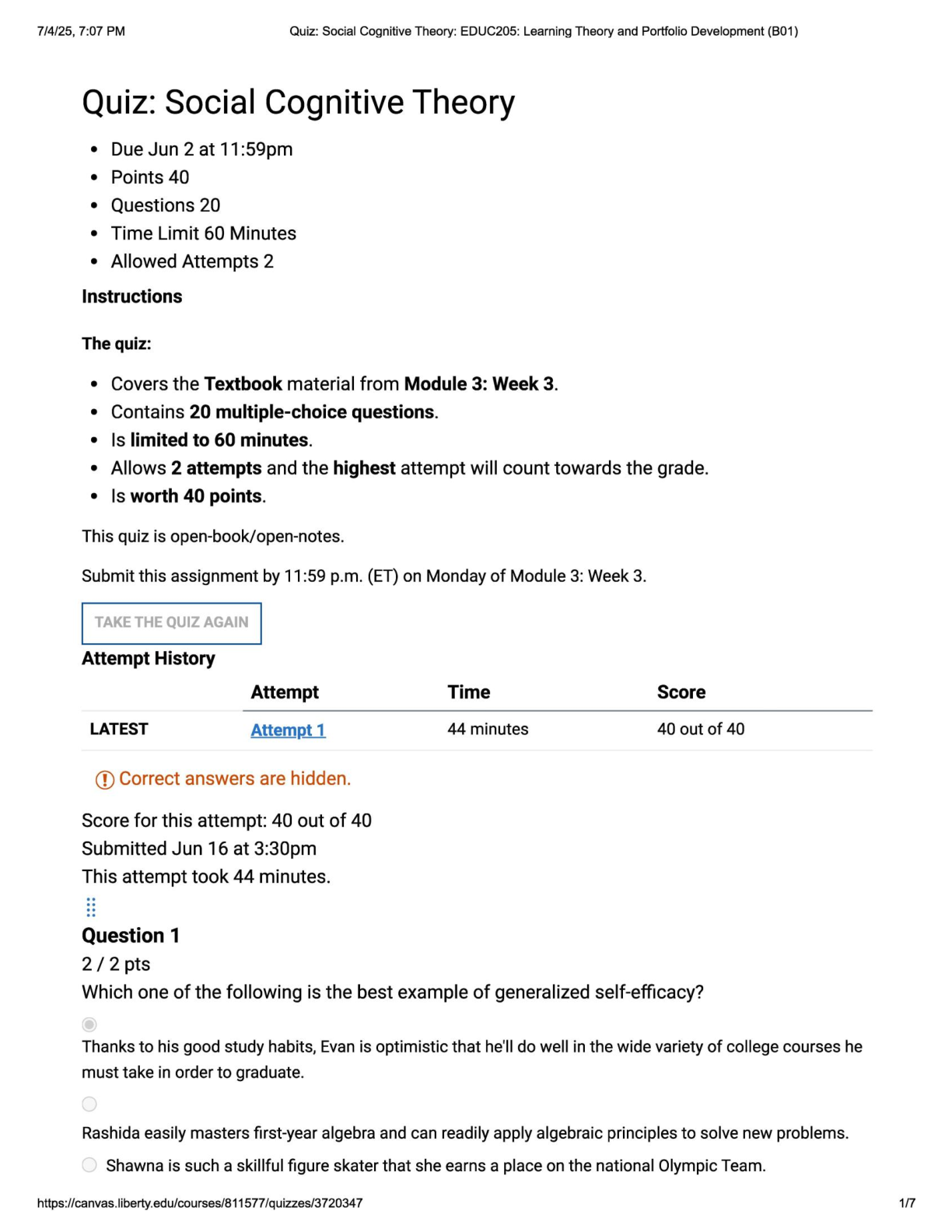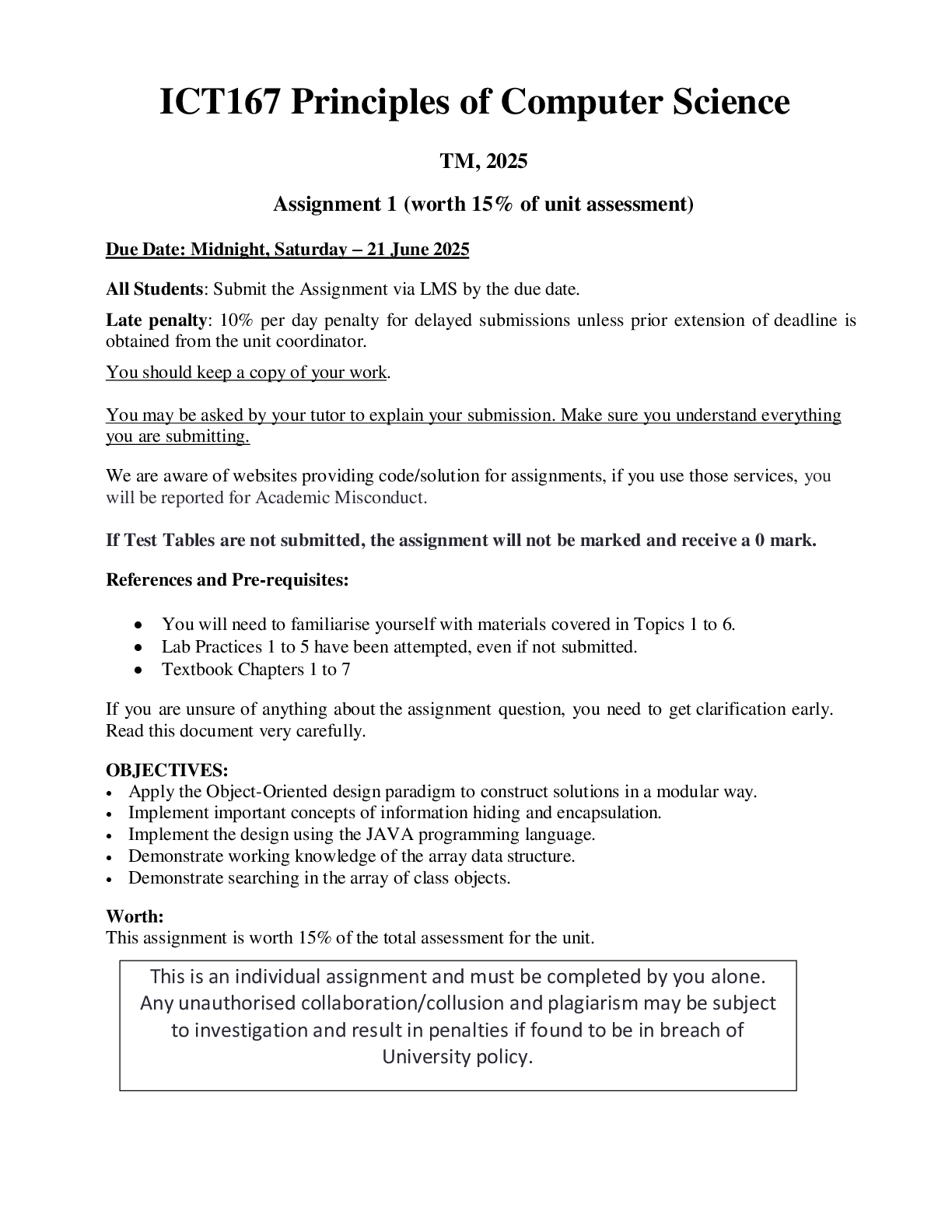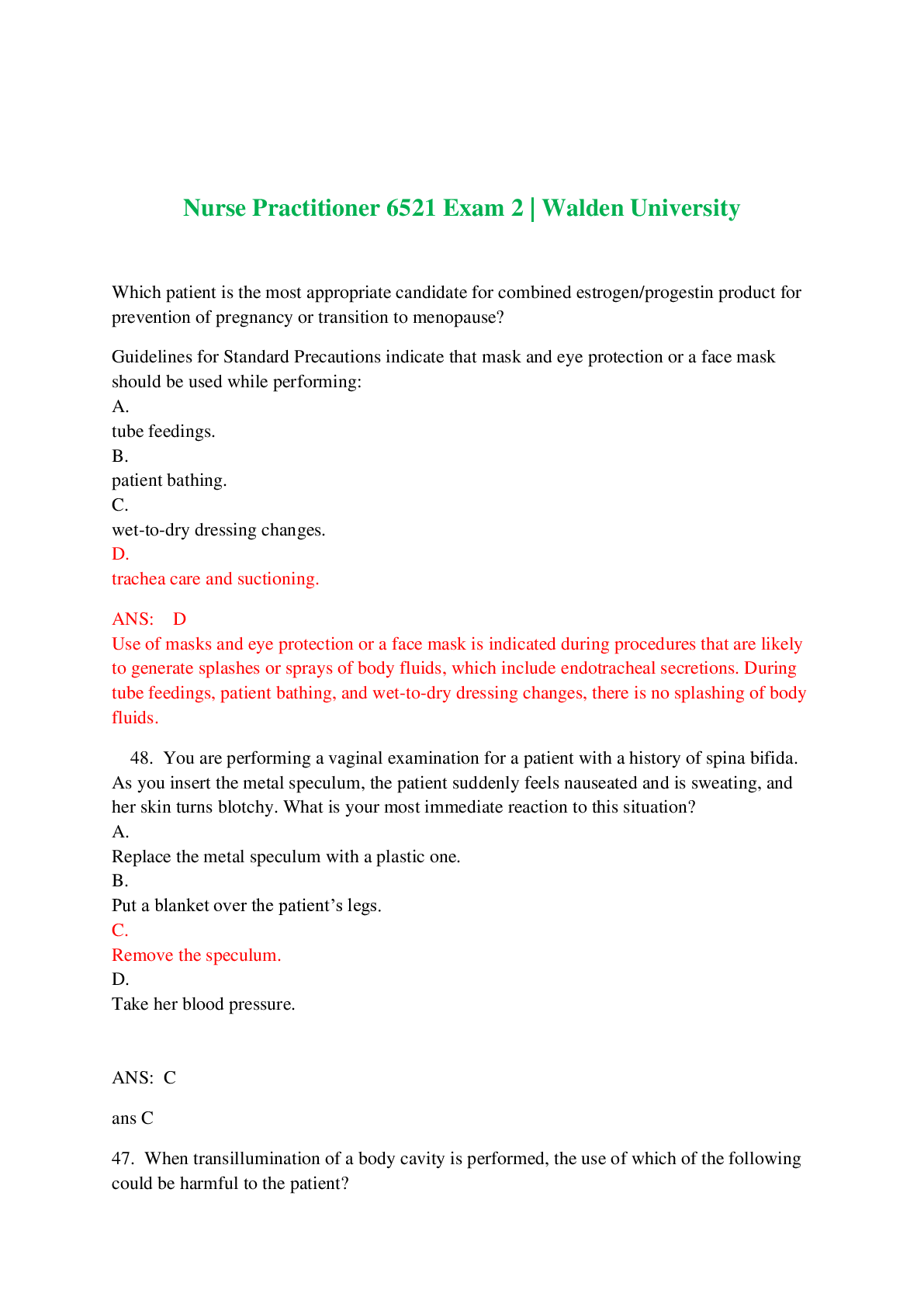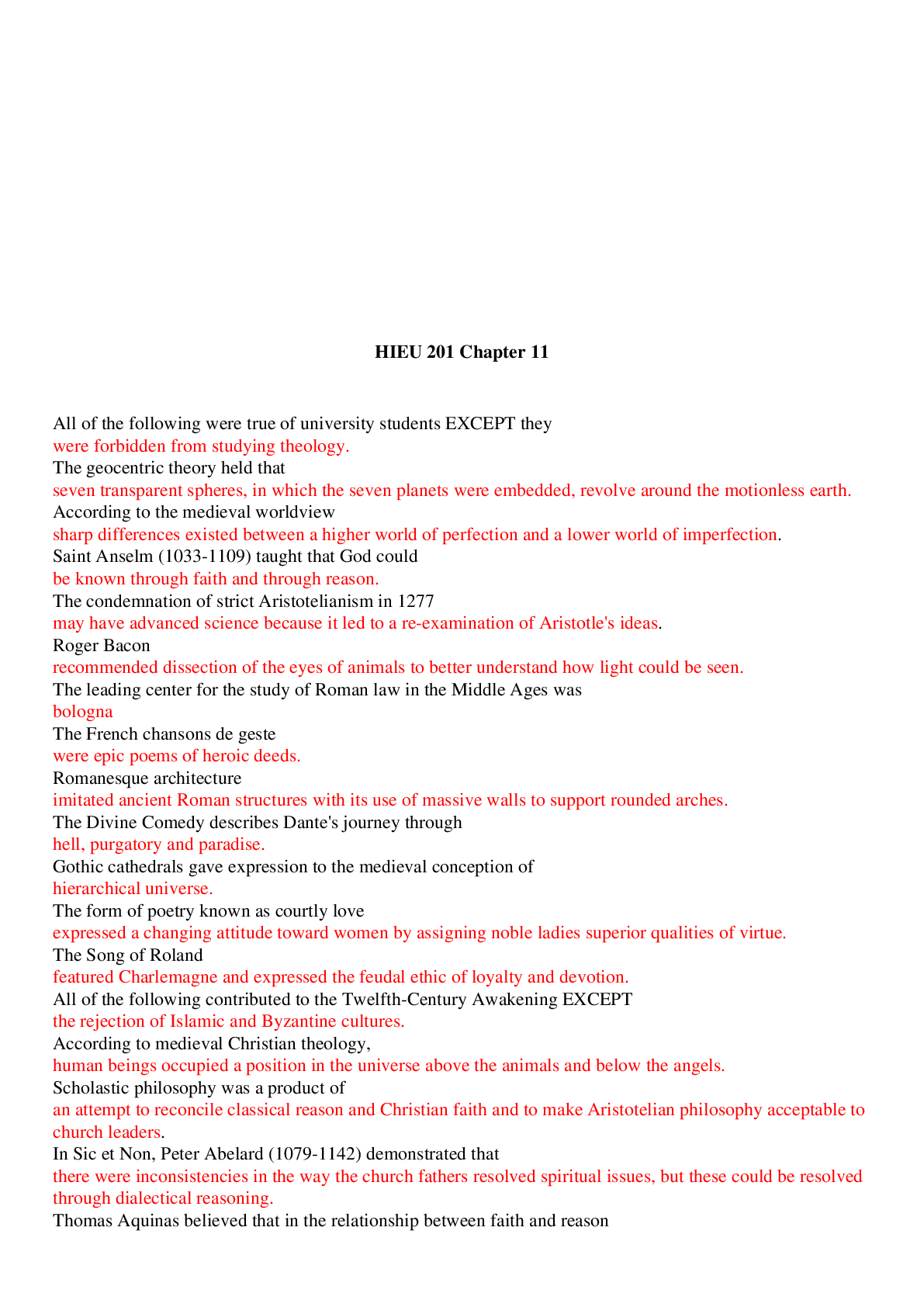Anthropology > EXAM > ANT 2410 Exam 5 | Questions and Answers (Complete Solutions) (All)
ANT 2410 Exam 5 | Questions and Answers (Complete Solutions)
Document Content and Description Below
ANT 2410 Exam 5 | Questions and Answers (Complete Solutions) Recent research on the origins of language suggests that a key mutation might have something to do with it. Comparing chimp and human ge ... nomes, it appears that a) chimps share with humans all the genetic propensities for language but lack the language-activation mutation b) speech-friendly mutation occurred among Neandertals in Europe and spread to other human populations through gene flow c) chimps lack the tongue-rolling gene that all humans have, which might explain why they struggle to achieve clear speech d) the speech-friendly form of the gene FOXP2 took hold in humans some 150,000 years ago e) the speech mutation occurred even before the hominin line split from the rest of the hominids. Which of the following statements about sociolinguists is NOT true? a)They are more interested in the rules that govern language than the actual use of language in everyday life. b) They focus on surface structure. c) They look at society and at language. d) They are concerned more with performance than with competence. e) They are concerned with linguistic change. Which of the following statements about chimpanzee call systems is NOT true? a) They consist of a limited number of sounds. b) They consist of sounds that vary in intensity and duration. c) Calls cannot be combined when multiple stimuli are present. d) They are stimuli dependent. e) Like language, they include displacement and cultural transmission. Words that clearly descend from the same ancestral word are known as a) daughters. b) homonyms. c) subgroups. d) synonyms. e) cognates. What term refers to the arrangement and order of words into sentences? a) lexicon b) morphology c) phonology d) syntax e) grammar As we see in the film "Pidgin: The Voice of Hawai'i," how is speech related to wider social and cultural issues? a) Certain kinds of speech are stigmatized. b) Certain kinds of speech are related to socio-economic class. c) Certain kinds of speech are validated. d) All answers are correct. e) Certain kinds of speech are related to ethnic identity. As we see in the film "Pidgin: The Voice of Hawai'i," what is a historical and social factor that led to the development of pidgin in Hawai'i? a) All answers are correct. b) Immigrant groups not having proper languages of their own and so they had to be taught by plantation owners. c) Immigrant groups working on plantations completely forgetting their native languages. d) Immigrant groups working on plantations not having the ability to adapt to new circumstances. e) Immigrant groups from many parts of the world working on plantations needing to communicate with each other. What is the study of the sounds used in speech? a) phonetics b) phonemics c) phones d) phonemes e) phonology Romance languages like French and Spanish are daughter languages of Latin, which is their common a) diglossia. b) protolanguage. c) call system. d) syntax. e) focal vocabulary. What are the effects of globalization on language? a) The development of programs to prevent language loss. b) The increasing number of loan words in languages increases. c) A diminishment of the diversity of languages around the world. d) Some languages are being lost when coming into contact with more political powerful speakers of other languages. e) All answers are correct. What term refers to languages that have descended from the same ancestral language? a) brother languages b) F2 languages c) protolanguages d) sibling languages e) daughter languages Why is language so important for the learning of culture? a) Language allows us to talk about the past, present, and future. b) Language allows us to communicate abstract ideas. c) Without language it would be difficult for children to learn. d) All answers are correct. e) Language conveys meaning. What term refers to the existence of "high" and "low" dialects within a single language? a) kinesics b) displacement c) diglossia d) semantics e) lexicon What are phonemes? a) regional differences in dialect b) syntactical structures that distinguish passive constructions from active ones c) the rules by which deep structure is translated into surface structure d) the minimal sound contrasts that distinguish meaning in a language e) electromagnetic signals that carry messages between speakers in a telephone conversation In linguistics, what is "abstraction?" a) No answers are correct. b) The pidgin word from Hawai'i that young men use when they do lots of sit-ups and then compare each other's abdominal muscles ("abs"). c) The ability to paint a description with words that make the listeners feel they are there in the place described. d) The ability to think and communicate about things that are not really there or don't really exist. e) The sophisticated language of art critics, as seen in the lecture. What is an example of what Bourdieu calls symbolic domination in the context of language use? a) in an egalitarian society, the promotion of linguistic diversity b) the fact that in a stratified society, even people who do not speak the prestige dialect tend to accept it as standard or superior c) Chomsky's insistence that the universal grammar defines all culture d) focal vocabulary contrasts among groups e) pride in one's linguistic heritage, regardless of what the majority thinks The lexicon of a language is a) the set of rules that govern the written but not spoken language. b) a dictionary containing all of its morphemes and their meanings. c) the range of speech sounds. d) its degree of complexity. e) its symbolic and poetic value. One aspect of linguistic history is language loss. When a language disappears, a) cultural diversity is reduced as well. b) humanity is that much closer to global integration. c) so does pride in one's heritage. d) less strain is put on the educational system, because it has less language diversity to deal with. e) historical linguists have confirmation that language is also a victim of evolutionary forces. Sapir and Whorf argued that the grammatical categories of different languages lead their speakers to think about things in particular ways. However, studies on the differences between female and male Americans with regard to the color terms they use suggest that a) women spend more money on status goods than do men. b) in support of the Sapir-Whorf hypothesis, different languages produce different ways of thinking. c) changes in the U.S. economy, society, and culture have had no impact on the use of color terms, or on any other terms for that matter. d) women and men are equally sensitive to the marketing tactics of the cosmetic industry. e)contrary to the Sapir-Whorf hypothesis, it might be more reasonable to say that changes in culture produce changes in language and thought, rather than the reverse. As we see in the film "Pidgin: The Voice of Hawai'i," what is the relationship between speaking pidgin and native Hawaiian identity? a) Native Hawaiians were always encouraged to speak the Hawaiian language and so they never spoke pidgin. b) The relationship between speaking pidgin and native Hawaiian identity has changed over the years as the Hawaiian language has been revitalized. c) Speaking pidgin was used to exclude native Hawaiians and speak about them behind their backs. d) All answers are correct. e) Native Hawaiians have always refused to speak pidgin. ________ refers to the specialized set of terms and distinctions that are particularly important to certain groups. a) Syntactical vocabulary b) Vernacular vocabulary c) Spatial vocabulary d) Temporal vocabulary e) Focal vocabulary Just as in other areas of anthropology, the study of language involves investigating what is or isn't shared across human populations and why these differences or similarities exist. The linguist Noam Chomsky has argued that the human brain contains a limited set of rules for organizing language, so that all languages have a common structural basis. He calls this set of rules a) the evolutionary linguistic imprint. b) a global mental map. c) the universal grammar. d) linguistic structuralism. e) generalities. What is the difference between human speech and non-human animal communication? a) Teaching sign language to Koko the gorilla demonstrates that non-human animals can be taught as much language as humans possess. b) No answers are correct. c) While both humans and non-human animals can communicate, recent studies have shown that non-human animals are just as capable as humans of producing the same number, complexity, and sophistication of sounds, body movements, and gestures that make up language - but it's just that humans didn't realize this until recently. d) While both humans and non-human animals can communicate, only humans are capable of producing the number, complexity, and sophistication of sounds, body movements, and gestures that make up language. e) There is no difference if whales and chimpanzees can communicate with each other. As we see in the film "Pidgin: The Voice of Hawai'i," youth and college-age speakers of pidgin a) Are embarrassed of speaking pidgin with each other. b) No answers are correct. c) Do not have a command of standard English and so they must speak pidgin. d) Never use pidgin to speak with each other when they visit the mainland. e) Are unable to communicate complex thoughts in pidgin. What is the term for variations in speech due to different contexts or situations? a) Chomskian verbosity b) situational syntax c) contextual phonetics d) style shifting e) linguistic confusion This is the smallest unit of sound that speakers of a language recognize as distinct from other sounds: a) Morphemes b) No answers are correct. c) Syntax d) Lexicon e) Phonemes This is a sequence of sounds that carries meaning, that is, words and their meaningful parts: a) Phonemes b) Lexicon c) No answers are correct. d) Morphemes e) Syntax Which of the following is considered a property of language? a) Displacement - language makes it possible to communicate about people and things that are not present. b) All answers are correct. c) Arbitrariness - the meaning of an individual word is arbitrary d) Productivity - a finite number of words can be combined into an infinite number of sentences. e) Discreteness - discrete elements can be recombined in novel ways. Which of the following was studied by Sapir and Whorf? a) the interaction of thought and surface structure b) the influence of deep structure on semantic domains c) the influence of deep structure on surface structure d) the influence of culture on language e) the influence of language on thought What type of term is used to convey or imply a status difference between the speaker and the person being referred to or addressed? a) linguistic relational b) honorifics c) style shifts d) formal addresses, but sociolinguists rarely pay attention to them, because their use in a social situation is always a result of linguistic exploitation e) diglossia Research on the communication skills of nonhuman primates reveals their inability to refer to objects that are not immediately present in their environment, such as food and danger. The ability to describe things and events that are not present is called a) phonology. b) displacement. c) linguistic imagination. d) productivity. e) cultural transmission. A sociolinguist studies a) cross-cultural comparisons of phonemic distinctions. b) the universal grammar of language. c) the interaction of history and sociology. d) speech in its social context. e) linguistic competence. A key feature of language that helps explain anthropologists' continued interest in studying it is that it a) tells us a lot about the present, although nothing about the past. b) helps them distinguish between the more and less evolved human races. d) rarely changes, so it provides a good window into linguistic uses of the past. d) enables us to compare human and nonhuman primate linguistic grammars. e) is always changing Language and communication involve much more than just verbal speech. The study of communication through body movements, stances, gestures, and facial expressions is known as a) diglossia. b) kinesics. c) linguistic physiology. d) biosemantics. e) protolinguistics. What is the term for the ability to create new expressions by combining other expressions? a) displacement b) productivity c) diglossia d) phonemic utility e) morphemic utility As we see in the film "Pidgin: The Voice of Hawai'i," because pidgin is stigmatized a) No answers are correct. b) There are no groups trying to promote pidgin. c) Pidgin is dying on its own and so most Hawaiians feel there is no need to either prohibit or promote pidgin. d) There is widespread apathy - no one really cares about pidgin one way or another. e) There are groups trying to promote pidgin to improve the image of the language. When does copula deletion (absence of the verb "to be") occur in AAVE? a) in the past tense b) in the future tense c) in SE, not AAVE d) randomly e) where SE has contractions The Malagasy development program described in this chapter illustrates the importance of a) the local government's ability to improve the lives of its citizens, when committed to doing so. b) breaking down corporate descent groups, which are too independent and interfere with development. c) replacing outdated traditional techniques of irrigation with more modern ones. d) the top-down strategies developed by the UN. e) replacing subsistence farming with a viable cash crop. As we see in the Prezi "This is Anthropology," the University of South Florida graduate students a) Disagreed strongly with then-Florida Gov. Rick Scott's depictions of anthropologists and showed how useful anthropology can be. b) Agreed with then-Florida Gov. Rick Scott's depictions of anthropologists and changed their majors. c) Disagreed strongly with then-Florida Gov. Rick Scott's depictions of anthropologists but did nothing in response. d) No answers are correct. e) Disagreed strongly with then-Florida Gov. Rick Scott's depictions of anthropologists but still changed their majors. People are usually willing to change just enough to maintain, or slightly improve on, what they already have. For this reason, development projects are most likely to succeed when they avoid the fallacy of a) ethno-bias. b) overinnovation. c) underdifferentiation. d) intervention philosophy. e) cultural relativism. Which of the following is true about medical anthropology? a) This growing field considers the biocultural context and implications of disease and illness. (NO) b) Typically in cooperation with pharmaceutical companies, this field does market research on the use of health products around the world. c) It applies non-Western health knowledge to a troubled industrialized medical system. (NO) d) It is the field that proved that people from rural areas suffer only from illnesses and not diseases. e) This field applies Western medicine to solving health problems around the world. (NO) Recall the account in the Kottak book on how McDonald's was able to succeed in the Brazilian market once it adapted to preexisting Brazilian cultural patterns. This example illustrates a) how the axiom of applied anthropology that innovation succeeds best when it is culturally appropriate applies not just to development projects but also to businesses, such as fast food. b) applied anthropology's capacity to help foreign markets adapt to a marketing strategy that must, above all costs, maintain the integrity of its brand. c) Brazilians' intolerance of foreign goods, because the companies that produce them disregard Brazilian tastes. d) the danger of applied anthropology turning itself into a tool of capitalist interests, which always disregard the culture and well-being of the consumer. e) how the axiom of applied anthropology that innovation succeeds best when it is culturally appropriate applies only in Western cultures. What is the commonly stated goal for most development projects? a) increased equity b) cultural assimilation c) greater socioeconomic stratification d) decreased local autonomy e) ethnocide What term refers to the tendency to view less developed countries as more alike than they are? a) ethnobias b) intervention philosophy c) cultural relativism d) underdifferentiation e) overinnovation Development projects should aim to accomplish all of the following EXCEPT a) promoting change, but not overinnovation. b) developing strategies with little input from the local communities. c) drawing models of development from indigenous practices. d) respecting local traditions. e) preserving local systems while working to make them better. Which of the following statements is true of your professor's research in the Caribbean? a) He shows how women's wages are equal to men's in world market factories. b) No answers are correct. c) He shows how women are favored as workers in many world market factories. d) He shows how wages in Caribbean factories are in line with those in the United States. e) He shows how women are hardly ever hired as workers in many world market factories. [Show More]
Last updated: 9 months ago
Preview 5 out of 22 pages

Loading document previews ...
Buy this document to get the full access instantly
Instant Download Access after purchase
Buy NowInstant download
We Accept:

Also available in bundle (1)
Click Below to Access Bundle(s)

ANT 2410 EXAM 2 - 5 BUNDLE
ANT 2410 EXAM 2 - 5 BUNDLE
By Ajay25 9 months ago
$29.5
4
Reviews( 0 )
$18.00
Can't find what you want? Try our AI powered Search
Document information
Connected school, study & course
About the document
Uploaded On
Mar 06, 2025
Number of pages
22
Written in
All
Additional information
This document has been written for:
Uploaded
Mar 06, 2025
Downloads
0
Views
61


























